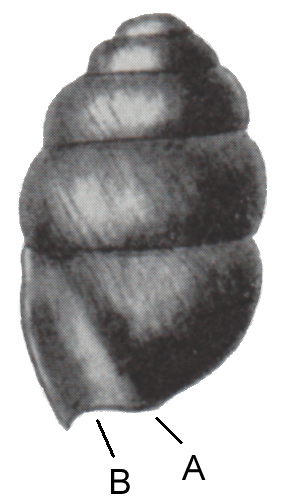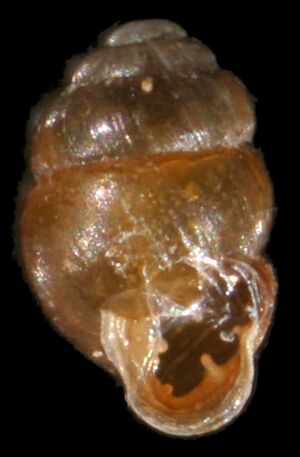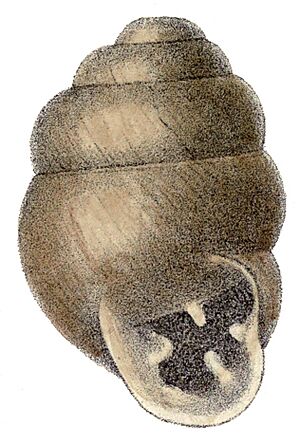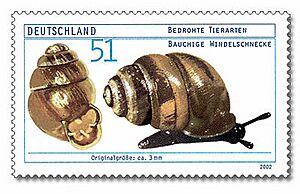Desmoulin's whorl snail facts for kids
Quick facts for kids Desmoulin's whorl snail |
|
|---|---|
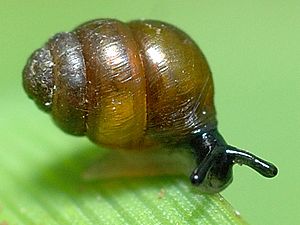 |
|
 |
|
| Vertigo moulinsiana Holotype MHNT | |
| Conservation status | |
| Scientific classification | |
| Synonyms | |
|
The Desmoulin's whorl snail (scientific name: Vertigo moulinsiana) is a tiny land snail. It's so small, it's often called a micromollusc! This snail breathes air and belongs to a group called Vertiginidae, the whorl snails.
This special snail was named after Charles des Moulins. He was a French naturalist who lived in the early 1800s.
Contents
Where Does the Snail Live?
Desmoulin's whorl snail loves wet places. It lives in wetlands that have lots of calcium. You can often find it among tall plants. These plants include sedges, saw-sedge (Cladium mariscus), reed-grass (Glyceria maxima), or common reed (Phragmites australis).
Where Can You Find This Snail?
This little snail lives across Europe. Its range stretches as far north as southern Sweden. It is also found in parts of North Africa.
In Western Europe, the largest groups of these snails are in Great Britain and Ireland. Other populations exist in countries like the Czech Republic and Poland. In these places, the snail is considered critically endangered. This means it is at a very high risk of disappearing.
You can also find this snail in many other European countries. These include Belgium, Switzerland, Italy, Germany, Austria, Slovakia, Hungary, Romania, Denmark, Norway, Finland, Latvia, Lithuania, Estonia, Belarus, Ukraine, Russia, Georgia, and Azerbaijan. It has also been found in Algeria and Morocco. However, it might no longer exist in Algeria.
The European Union cares about this snail. It is listed in Annex II of the European Union's Habitats Directive. This means special efforts are made to protect it.
Status in the United Kingdom
In the United Kingdom, the Desmoulin's whorl snail is listed as endangered. It lives in several areas from Norfolk to Dorset. There are also groups in Kent and the Llŷn Peninsula in North Wales. People think it might have been missed in the past because it is so tiny.
Once, the snail's presence stopped a road project. This was the planned Newbury bypass. The road building was delayed until the snails could be moved. They were taken to a new home nearby. However, reports suggest the snails later died out at that new site. Still, the snail is now thought to be less rare than it was ten years ago.
What Does Its Shell Look Like?
The shell of the Desmoulin's whorl snail is very small. It is usually about 3 millimeters long. The shell is yellowish or brownish and you can see through it a little.
The shell spirals to the right. It is shaped like an egg and is a bit swollen. The top part, called the apex, is rounded. The shell feels smooth and looks shiny.
It has four whorls, which are like turns in a spiral. These turns are separated by clear lines called sutures. The last whorl is twice as big as all the others put together.
The opening of the shell, called the aperture, is shaped like half an oval. It has four small "teeth" inside. One tooth is on the inner wall, one is on the central pillar (called the columella), and two are on the outer lip. The lower of these two is longer.
On a Stamp
In 2002, Deutsche Post in Germany featured Vertigo moulinsiana on a postage stamp. It was a €0.51 stamp. This stamp was part of a series that showed endangered species of animals.



